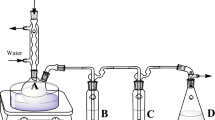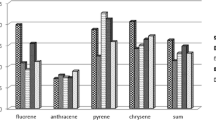Abstract
Creosote is a multicomponent oil classified as a dense non-aqueous phase liquid (DNAPL) produced from coal tar distillation. The concept of phase distribution is critical in decision-making to remediate contaminated sites. The creosote mass transfer between sorbed, aqueous, vapor, and DNAPL phases is controlled by physicochemical characteristics, geology of the site, and environment conditions. This study evaluated phase distribution of the main polycyclic aromatic hydrocarbons (PAHs) of creosote in a sandy soil with low organic matter content. The creosote was collected from a contaminated site in São Paulo, Brazil, and was characterized by gas chromatography–mass spectrometry (GC-MS). Clean soil was collected upgradient from the same area. Initially, the soil was artificially contaminated with creosote. After, the contaminated soil was put in contact with clean water in sealed vials for 72 h. Samples of the soil, vapor, and liquid phases were collected and analyzed by GC-MS. In total, 50 compounds were identified in the creosote, and 9 PAHs were selected to be studied, which represented around 30% of total creosote mass. The major contaminant concentration was detected in the sorbed phase. For instance, naphthalene mass was distributed in sorbed (33.0%), DNAPL (1.5%), aqueous (3.4%), and vapor (0.2%) phases. The results provided an understanding of the contaminant species partitioning that occurs in a real contaminated site.


Similar content being viewed by others
Abbreviations
- ACE:
-
Acenaphthene
- ANT:
-
Anthracene
- BAA:
-
Benz[a]anthracene
- DCM:
-
Dichloromethane
- DNAPL:
-
Dense non-aqueous phase liquid
- FLT:
-
Fluoranthene
- FLU:
-
Fluorene
- GC-MS:
-
Gas chromatography–mass spectrometry
- MNAP:
-
2-Methylnaphthalene
- NAP:
-
Naphthalene
- NAPL:
-
Non-aqueous phase liquid
- PAHs:
-
Polycyclic aromatic hydrocarbons
- PHE:
-
Phenanthrene
- PYR:
-
Pyrene
- SVOC:
-
Semi-volatile organic compound
- UQG:
-
Unquantified group
- US EPA:
-
United States Environmental Protection Agency
- VOC:
-
Volatile organic compound
References
Anwar, A. F. (2013). Mass transfer characteristics of nonaqueous phase liquid based on air–liquid interfacial area in variably saturated porous media. Water, Air, & Soil Pollution. https://doi.org/10.1007/s11270-013-1567-4.
Bezza, F. A., & Chirwa, E. M. N. (2016). Biosurfactant-enhanced bioremediation of aged polycyclic aromatic hydrocarbons (PAHs) in creosote contaminated soil. Chemosphere. https://doi.org/10.1016/j.chemosphere.2015.08.027.
Brion, D., & Pelletier, É. (2005). Modelling PAHs adsorption and sequestration in freshwater and marine sediments. Chemosphere. https://doi.org/10.1016/j.chemosphere.2005.04.097.
CETESB. (2016). Valores Orientadores para Solos e Águas Subterrâneas no Estado de São Paulo. São Paulo, Brasil: https://cetesb.sp.gov.br/aguas-subterraneas/wp-content/uploads/sites/13/2013/11/tabela_vos_2016_site.pdf. .
CETESB - Companhia Ambiental do Estado de São Paulo, (2019). Ficha de Informação de Produto Químico. https://sistemasinter.cetesb.sp.gov.br/produtos/ficha_completa1.asp?consulta=COAL%20TAR%20-%20CREOSOTO.
Cornelissen, G., Gustafsson, Ö., Bucheli, T. D., Jonker, M. T., Koelmans, A. A., & van Noort, P. C. (2005). Extensive sorption of organic compounds to black carbon, coal, and kerogen in sediments and soils: mechanisms and consequences for distribution, bioaccumulation, and biodegradation. Environmental Science & Technology. https://doi.org/10.1021/es050191b.
Cousins, I. T., Beck, A. J., & Jones, K. C. (1999). A review of the processes involved in the exchange of semi-volatile organic compounds (SVOC) across the air-soil interface. Science of the Total Environment. https://doi.org/10.1016/S0048-9697(99)00015-7.
Embrapa Solos (Centro Nacional de Pesquisa de Solos), (1997). Manual de Métodos de Análise de Solo. https://www.agencia.cnptia.embrapa.br/Repositorio/Manual+de+Metodos_000fzvhotqk02wx5ok0q43a0ram31wtr.pdf.
Evans, M. S., Fazakas, K., & Keating, J. (2009). Creosote contamination in sediments of the Grey Owl Marina in Prince Albert National Park, Saskatchewan, Canada. Water, Air, & Soil Pollution, 201(1–4). https://doi.org/10.1007/s11270-008-9935-1.
Fetter, C. W. (2000). Applied hydrogeology (fourth ed.). Waveland Press, Inc..
Forsey, S. (2004). In situ chemical oxidation of creosote/coal tar residuals: experimental and numerical investigation.
Gan, S., Lau, E. V., & Ng, H. K. (2009). Remediation of soils contaminated with polycyclic aromatic hydrocarbons (PAHs). Journal of Hazardous Materials. https://doi.org/10.1016/j.jhazmat.2009.07.118.
Huling, S. G., & Weaver, J. W. (1991). Ground water issue: dense nonaqueous phase liquids. US Environmental Protection Agency https://www.epa.gov/sites/production/files/2015-06/documents/dnapl_issue_paper.pdf.
IPCS International Programme on Chemical Safety. (2004). Concise International Chemical Assessment Document 62. Coal tar creosote. Geneva, World Health Organization. ISBN 92 4 153062 6/ ISSN 1020–6167.
Kim, P. G., Roh, J. Y., Hong, Y., & Kwon, J. H. (2017). Effects of soil water saturation on sampling equilibrium and kinetics of selected polycyclic aromatic hydrocarbons. Chemosphere. https://doi.org/10.1016/j.chemosphere.2017.05.170.
Kohler, M., Künniger, T., Schmid, P., Gujer, E., Crockett, R., & Wolfensberger, M. (2000). Inventory and emission factors of creosote, polycyclic aromatic hydrocarbons (PAH), and phenols from railroad ties treated with creosote. Environmental Science & Technology. https://doi.org/10.1021/es000103h.
Kueper, B. H., Wealthall, G. P., Smith, J. W. N., Leharne, S. A., & Lerner, D. N. (2003). An illustrated handbook of DNAPL transport and fate in the subsurface. Bristol: Environment Agency.
Kuusimäki, L., Peltonen, K., Mutanen, P., & Savela, K. (2003). Analysis of particle and vapour phase PAHs from the personal air samples of bus garage workers exposed to diesel exhaust. The Annals of Occuppation Hygiene. https://doi.org/10.1093/annhyg/meg037.
Lee, K. Y., & Chrysikopoulos, C. V. (2006). Dissolution of a multicomponent DNAPL pool in an experimental aquifer. Journal of Hazardous Materials. https://doi.org/10.1016/j.jhazmat.2005.08.005.
Lin, L., Dong, L., Meng, X., Li, Q., Huang, Z., Li, C., et al. (2018). Distribution and sources of polycyclic aromatic hydrocarbons and phthalic acid esters in water and surface sediment from the Three Gorges Reservoir. Journal of Environmental Sciences. https://doi.org/10.1016/j.jes.2017.11.004.
Lion, L. W. (1990). Sorption and transport of polynuclear aromatic hydrocarbon in low-carbon aquifer materials. Ithaca: Cornell Univ Ithaca NY Dept of Civil and Environmental Engineering https://apps.dtic.mil/dtic/tr/fulltext/u2/a242895.pdf.
Luthy, R. G., Aiken, G. R., Brusseau, M. L., Cunningham, S. D., Gschwend, P. M., Pignatello, J. J., et al. (1997). Sequestration of hydrophobic organic contaminants by geosorbents. Environmental Science & Technology. https://doi.org/10.1021/es970512m.
Mackay, D., Shiu, W. Y., Ma, K. C., & Lee, S. C. (2006). Handbook of physical-chemical properties and environmental fate for organic chemicals. CRC press., second ed. Boca Raton. https://doi.org/10.1201/9781420044393.
Mendes, G. P., Magalhães, V. M., Soares, L. C., Aranha, R. M., Nascimento, C. A., Vianna, M. M., & Chiavone-Filho, O. (2020). Treatability studies of naphthalene in soil, water and air with persulfate activated by iron (II). Journal of Environmental Sciences. https://doi.org/10.1016/j.jes.2019.11.015.
Miller, M. M., Wasik, S. P., Huang, G. L., Shiu, W. Y., & Mackay, D. (1985). Relationships between octanol-water partition coefficient and aqueous solubility. Environmental Science & Technology. https://doi.org/10.1021/es00136a007.
Newell, C.J., Acree, S.D., Ross, R.R., Huling, S.G. (1995). Ground water issue: Light nonaqueous phase liquids. Houston.
Nylund, L., Heikkilä, P., Hämeilä, M., Pyy, L., Linnainmaa, K., & Sorsa, M. (1992). Genotoxic effects and chemical compositions of four creosotes. Mutation Research/Fundamental and Molecular Mechanisms of Mutagenesis, https://doi.org/10.1016/0027-5107(92)90051-3
Priddle, M. W., & MacQuarrie, K. T. (1994). Dissolution of creosote in groundwater: An experimental and modeling investigation. Journal of Contaminant Hydrology. https://doi.org/10.1016/0169-7722(94)90009-4.
Rivas, F. J. (2006). Polycyclic aromatic hydrocarbons sorbed on soils: a short review of chemical oxidation based treatments. Journal of Hazardous Materials. https://doi.org/10.1016/j.jhazmat.2006.07.048.
Scherr, K. E., Vasilieva, V., Lantschbauer, W., & Nahold, M. (2016). Composition and dissolution of a migratory, weathered coal tar creosote DNAPL. Frontiers in Environmental Science. https://doi.org/10.3389/fenvs.2016.00061.
Staudinger, J., & Roberts, P. V. (1996). A critical review of Henry’s law constants for environmental applications. Critical Reviews in Environmental Science and Technology. https://doi.org/10.1080/10643389609388492.
Sui, H., Li, L., Zhu, X., Chen, D., Wu, G., 2016. Sui, H., Li, L., Zhu, X., Chen, D., & Wu, G. (2016). Modeling the adsorption of PAH mixture in silica nanopores by molecular dynamic simulation combined with machine learning. Chemosphere, https://doi.org/10.1016/j.chemosphere.2015.10.053.
US EPA - United States Environmental Protection Agency. (1996). Method 3510C - separatory funnel liquid-liquid extraction. https://www.epa.gov/sites/production/files/2015-12/documents/3510c.pdf Accessed June 22, 2020.
US EPA - United States Environmental Protection Agency. (1998). Method 8270D - semivolatile organic compounds by gas chromatography/mass spectrometry (GC/MS). Washington. https://archive.epa.gov/epa/sites/production/files/2015-12/documents/8270d.pdf. .
US EPA - United States Environmental Protection Agency. (2014). Priority pollutant list. https://www.epa.gov/sites/production/files/2015-09/documents/priority-pollutant-list-epa.pdf. .
US EPA - United States Environmental Protection Agency. (2019). Regional Screening Level (RSL) Summary Table (TR=1E-06, HQ=1). https://semspub.epa.gov/work/HQ/199628.pdf. .
US EPA- United States Environmental Protection Agency. (2007). Method 3550C - Ultrasonic Extraction. https://www.epa.gov/sites/production/files/2015-12/documents/3550c.pdf.
USDA - United States Department of Agriculture. Soil Survey Division Staff. (1993). Clarification of soil texture class boundaries. https://www.nrcs.usda.gov/Internet/FSE_DOCUMENTS/nrcs142p2_031477.pdf. .
Wang, Z., Fingas, M., Yang, C., & Christensen, J. H. (1964). Crude oil and refined product fingerprinting: principles. In Environmental Forensics, Academic Press. https://doi.org/10.1016/B978-012507751-4/50038-0.
Wehrer, M., Rennert, T., & Totsche, K. U. (2013). Kinetic control of contaminant release from NAPLs–experimental evidence. Environmental Pollution. https://doi.org/10.1016/j.envpol.2013.03.041.
Wiłkomirski, B., Sudnik-Wójcikowska, B., Galera, H., Wierzbicka, M., & Malawska, M. (2011). Railway transportation as a serious source of organic and inorganic pollution. Water, Air, & Soil Pollution. https://doi.org/10.1007/s11270-010-0645-0.
Yalkowsky, S. H. (1979). Estimation of entropies of fusion of organic compounds. Industrial & Engineering Chemistry Fundamentals. https://doi.org/10.1021/i160070a003.
Yebra-Pimentel, I., Fernández-González, R., Martínez-Carballo, E., & Simal-Gándara, J. (2015). A critical review about the health risk assessment of PAHs and their metabolites in foods. Critical Reviews in Food Science and Nutrition. https://doi.org/10.1080/10408398.2012.697497.
Yuan, M., Tong, S., Zhao, S., & Jia, C. Q. (2010). Adsorption of polycyclic aromatic hydrocarbons from water using petroleum coke-derived porous carbon. Journal of Hazardous Materials. https://doi.org/10.1016/j.jhazmat.2010.05.130.
Acknowledgments
The authors would like to express their gratitude to the Coordenação de Aperfeiçoamento de Pessoal de Nível Superior (CAPES, Project PROCAD No. 88887.124192/2014-00), to the Conselho Nacional de Desenvolvimento Científico e Tecnológico (CNPq, Process No. 140302/2016-6), and to the Instituto de Pesquisas Tecnológicas (IPT) for providing the clean soil and creosote samples used in this study.
Author information
Authors and Affiliations
Corresponding author
Additional information
Publisher’s Note
Springer Nature remains neutral with regard to jurisdictional claims in published maps and institutional affiliations.
Rights and permissions
About this article
Cite this article
Macêdo Aranha, R., A. Magalhães, V.M., P. Mendes, G. et al. Characterization and Partitioning Behavior of Creosote in Different Matrices: Soil, Water, and Air. Water Air Soil Pollut 231, 402 (2020). https://doi.org/10.1007/s11270-020-04772-y
Received:
Accepted:
Published:
DOI: https://doi.org/10.1007/s11270-020-04772-y




